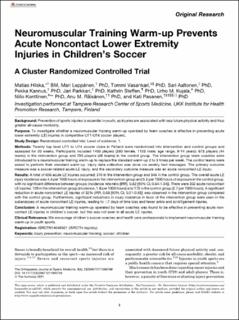| dc.contributor.author | Hilska, Matias | |
| dc.contributor.author | Leppänen, Mari | |
| dc.contributor.author | Vasankari, Tommi | |
| dc.contributor.author | Aaltonen, Sari | |
| dc.contributor.author | Kannus, Pekka | |
| dc.contributor.author | Parkkari, Jari | |
| dc.contributor.author | Steffen, Kathrin | |
| dc.contributor.author | Kujala, Urho M. | |
| dc.contributor.author | Konttinen, Niilo | |
| dc.contributor.author | Räisänen, Anu M. | |
| dc.contributor.author | Pasanen, Kati | |
| dc.date.accessioned | 2021-12-10T09:07:14Z | |
| dc.date.available | 2021-12-10T09:07:14Z | |
| dc.date.created | 2021-06-16T10:01:06Z | |
| dc.date.issued | 2021 | |
| dc.identifier.citation | Orthopaedic Journal of Sports Medicine. 2021, 9(4), Artikkel 23259671211005769. | en_US |
| dc.identifier.issn | 2325-9671 | |
| dc.identifier.uri | https://hdl.handle.net/11250/2833713 | |
| dc.description | This open-access article is published and distributed under the Creative Commons Attribution - NonCommercial - No Derivatives License (https://creativecommons.org/licenses/by-nc-nd/4.0/), which permits the noncommercial use, distribution, and reproduction of the article in any medium, provided the original author and source are credited. You may not alter, transform, or build upon this article without the permission of the Author(s). | en_US |
| dc.description.abstract | Background: Prevention of sports injuries is essential in youth, as injuries are associated with less future physical activity and thus greater all-cause morbidity.Purpose:To investigate whether a neuromuscular training warm-up operated by team coaches is effective in preventing acute lower extremity (LE) injuries in competitive U11-U14 soccer players.
Study Design: Randomized controlled trial; Level of evidence, 1.
Methods: Twenty top-level U11 to U14 soccer clubs in Finland were randomized into intervention and control groups and assessed for 20 weeks. Participants included 1403 players (280 female, 1123 male; age range, 9-14 years): 673 players (44 teams) in the intervention group and 730 players (48 teams) in the control group. The intervention group team coaches were introduced to a neuromuscular training warm-up to replace the standard warm-up 2 to 3 times per week. The control teams were asked to perform their standard warm-up. Injury data collection was done via weekly text messages. The primary outcome measure was a soccer-related acute LE injury, and the secondary outcome measure was an acute noncontact LE injury.
Results: A total of 656 acute LE injuries occurred: 310 in the intervention group and 346 in the control group. The overall acute LE injury incidence was 4.4 per 1000 hours of exposure in the intervention group and 5.5 per 1000 hours of exposure in the control group, with no significant difference between groups (incidence rate ratio [IRR], 0.82 [95% CI, 0.64-1.04]). There were 302 acute noncontact LE injuries: 129 in the intervention group (incidence, 1.8 per 1000 hours) and 173 in the control group (2.7 per 1000 hours). A significant reduction in acute noncontact LE injuries of 32% (IRR, 0.68 [95% CI, 0.51-0.93]) was observed in the intervention group compared with the control group. Furthermore, significant reductions in injury incidence in favor of the intervention group were seen in the subanalyses of acute noncontact LE injuries, leading to ≤7 days of time loss and fewer ankle and joint/ligament injuries.
Conclusion: A neuromuscular training warm-up operated by team coaches was found to be effective in preventing acute noncontact LE injuries in children’s soccer, but this was not seen in all acute LE injuries.
Clinical Relevance: We encourage children’s soccer coaches and health care professionals to implement neuromuscular training warm-up in youth sports. | en_US |
| dc.language.iso | eng | en_US |
| dc.subject | children | en_US |
| dc.subject | injury prevention | en_US |
| dc.subject | neuromuscular training | en_US |
| dc.subject | soccer | en_US |
| dc.title | Neuromuscular training warm-up prevents acute noncontact lower extremity injuries in children's soccer: A cluster randomized controlled trial | en_US |
| dc.type | Peer reviewed | en_US |
| dc.type | Journal article | en_US |
| dc.description.version | publishedVersion | en_US |
| dc.rights.holder | © The Author(s) 2021 | en_US |
| dc.source.pagenumber | 9 | en_US |
| dc.source.volume | 9 | en_US |
| dc.source.journal | Orthopaedic Journal of Sports Medicine | en_US |
| dc.source.issue | 4 | en_US |
| dc.identifier.doi | 10.1177/23259671211005769 | |
| dc.identifier.cristin | 1916057 | |
| dc.description.localcode | Institutt for idrettsmedisinske fag / Department of Sports Medicine | en_US |
| dc.source.articlenumber | 23259671211005769 | en_US |
| cristin.ispublished | true | |
| cristin.fulltext | original | |
| cristin.qualitycode | 1 | |
